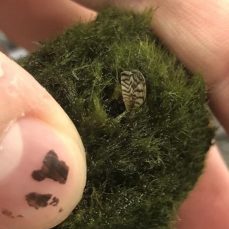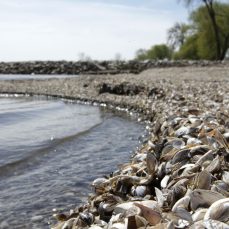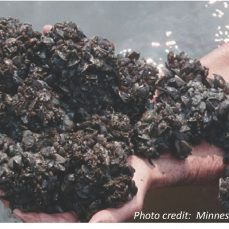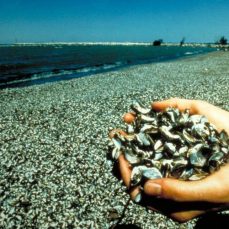
Management Category
Squamish
Whistler
Pemberton
Vectors of Spread
ID Characteristics
General: Zebra and quagga mussels are bivalve mollusks with similar biological and ecological traits.
Size: In general, adult mussels are very small. Recently settled mussels are only a few millimetres long and feel like sandpaper. Larval forms are free-swimming and are not visible to the naked eye.
- Zebra mussels: Zebra mussels are typically 2 – 2.5 cm large but can grow up to 4cm and are black or brown with white-yellow zigzagged patterns on their shell.
- Quagga mussels: Quagga mussels are an average of 2cm, but can reach up to 3cm. They have dark concentric rings on their shell, with a pale colour near the hinge.
Shape: Propeller blade or “D” shaped.
Similar Species
Native mussels: Compared to native mussels, zebra and quagga mussels are much smaller, and are found attached to surfaces. Native mussels are all free-living and do not attach to anything.

Habitat and Origin
Origin: Both zebra and quagga mussels originate from Europe. They are fresh water bivalves native to the Black Sea region. Zebra and quagga mussels were introduced to North America through the ballast water of trans-continental ships in the late 1980’s.
Habitat: Zebra and quagga mussels are highly adaptable and can survive in lakes displaying various environmental conditions and in water flowing up to 2 m per second. They attach themselves to hard surfaces like shorelines, docks, pipes, and the bottom of boats.
How They Spread
Zebra and quagga mussels reach maturity after 1-2 years. A mature female can produce one million eggs per season, and reproduction starts when the water temperature reaches 12 degrees Celcius or warmer.
- Invasive mussels are easily dispersed in their juvenile stages while they are tiny, free swimming larvae that cannot be seen by the naked eye. Any amount of water in or on a boat can contain this larvae. The larvae settle onto surfaces such as the hull of a boat or fishing gear, and slowly grow into adult mussels.
- Newly settled mussels are also difficult to detect as they are only a few mm’s across.
- Adult mussels can live out of the water for up to 30 days. Moving a boat, canoe, kayak, SUP, or fishing gear between water bodies can transport both the larvae and the adult mussel forms.
Impacts
Ecological Impacts
- One mussel can filter up to 1 litre of water a day! Zebra and quagga mussels filter out nutrients and micro-organisms such as plankton which are the base of the food chain for BC’s native aquatic species. This could result in the collapse of valuable native fish populations in BC such as sockeye salmon.
- Invasive mussels cause toxic algal blooms, which impact fish and wildlife.
- Zebra and quagga mussels also lead to increased growth of aquatic weeds along lake shorelines which degrades water quality and the aquatic environment.
Economic Impacts
- Invasive mussels overgrow and clog water intake pipes of power stations, municipal water supplies, and agricultural water intakes. They coat beaches, docks, and the propeller and hulls of boats to the point that they become unusable.
- The sharp shells of mussels can harm swimmers’ feet and decomposing mussels produce an unpleasant odour, thus impacting recreational beaches.
- The predicted cost of zebra and quagga mussels if they were introduced to BC ranges from $64 to $129 million annually.
Prevent the Spread
Zebra and quagga mussels have not yet been reported in BC, so PREVENTION is key!
Clean, drain, and dry your boat, trailer and other equipment before moving it to a new water body. This prevents the transport of invasive mussel adults or larvae between lakes and rivers.
- Clean: Remove plant fragments, aquatic species, and mud from any watercraft or equipment (boots, waders, fishing gear). If available, use a power wash station.
- Drain: Drain all items that can hold water onto land (e.g. buckets, bait water, wells, ballast, and bilge).
- Dry: Make sure all items are completely dry before entering a new water body.
It is illegal to transport invasive mussels anywhere in B.C.
BC Distribution

Invasive Mussel Factsheets
Having trouble viewing the factsheet? Don’t worry, all the information is included on this page. You can also contact us with any questions.
Additional Resources
References
- Alberta Invasive Species Council, Quagga Mussel
- Alberta Invasive Species Council, Zebra Mussel
- BC Ministry of Environment, BC Invasive Mussel Defence Program
- Invasive Species Council of British Columbia, Zebra and Quagga Mussels
- Ontario’s Invading Species Awareness Program, Zebra and Quagga Mussels
- Ontario Invasive Species Awareness Program, Mussel Factsheet
- United States Geological Society, Dreissena rostriformis bugensis

















